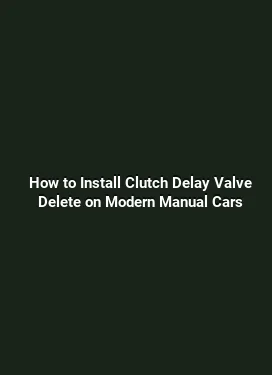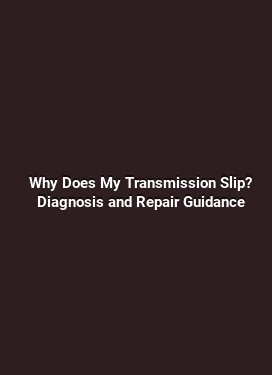Transfer Case Care: What 4x4 Owners Must Know in 2025
Maintaining a transfer case is essential for reliable four‑wheel drive performance, particularly as terrain, towing demands, and climate conditions evolve. A well cared‑for transfer case translates into smoother engagement, reduced drivetrain noise, and extended component life. This article dives into practical maintenance steps, inspection routines, and condition monitoring that 4x4 enthusiasts and daily drivers can apply without specialized equipment. The guidance blends fundamental principles with real‑world scenarios drawn from on‑ and off‑road experiences to help readers make informed decisions about service intervals, fluid choices, and common failure modes.
Understanding Transfer Case Basics

The transfer case sits between the transmission and the drive shafts, distributing power to the front and rear axles. It shifts between two‑wheel and four‑wheel drive configurations, and in many vehicles, it also provides a low‑range option for crawling or navigating steep terrain. Proper fluid and seal condition are what keep this system quiet and responsive, especially under heavy use or extreme temperatures.
Key components typically include a chain or bevel gear assembly, input and output shafts, a set of synchronizing or locking mechanisms, a fluid reservoir, and an actuator or manual linkage. The exact architecture varies by model and year, but the core goal remains the same: transfer torque efficiently while allowing slip when needed to prevent drivetrain binding. Modern transfer cases often integrate electronic controls, which coordinate engagement with transmission gear shifts, traction control, and stability systems. While electronics add convenience, they also introduce potential failure points that merit attention during routine checks.
Key Components and Functions

Understanding the main parts helps in diagnosing why a transfer case behaves abnormally. The chain or bevel gear set transfers torque from the input shaft to the output shafts. In many units, a loss of lubrication accelerates wear on the chain, guides, and gears, leading to slippage or a whine when the vehicle is in four‑wheel drive. An actuator or vacuum/shift motor engages the mode selector, switching between two‑wheel drive, four‑wheel drive high, and four‑wheel drive low in some configurations. A front‑axle disconnect, common in older setups, can cause drivetrain binding if seals leak or the mechanism sticks.
Fluid serves multiple roles: cooling the gear teeth, supplying lubrication to planetary bearings on some designs, and forming a hydraulic film that cushions shifting and engagement. Over time, fluid can degrade due to heat, contamination, or shear from worn components. When symptoms like hard engagement, grinding sounds, or intermittent four‑wheel drive occur, inspecting the transfer case fluid and seals is a sensible first step.
Fluid Fundamentals and Fluid Change Practices
Fluid choice and change intervals depend on the vehicle, its usage, and environmental conditions. Some transfer cases use gear oil, while others require automatic transmission fluid (ATF) or a specialized mineral or synthetic blend. It is important to consult the owner’s manual or a trusted service guide for the exact specification. In many cases, using the manufacturer’s recommended fluid type is the simplest way to ensure compatibility with seals and bearings over thousands of miles.
Regular fluid inspection is part of effective maintenance. Look for metallic debris on the dipstick or in the drain pan after a drain and fill, which can indicate excessive wear. Check for color changes, especially if the fluid looks burnt or has a strong, unusual odor. Fluid should be clean, with a reddish or amber tint in most ATF blends or a clear to amber tone in some gear oils. If the fluid is dark, gritty, or has a burnt smell, a replacement is warranted and, in some cases, a system flush may be considered by a professional.
When and How to Change the Fluid
For many 4x4 owners, a routine drain and fill is a practical maintenance task. Ensure the vehicle is level, remove the drain plug, and let the fluid completely drain into a suitable container. Replace the drain plug with a new gasket or washer if required, and then refill to the manufacturer’s specified level using the correct fluid type. Some transfer cases have a plug that doubles as an overflow; filling to this level ensures the case is not overfilled, which can cause pressure buildup and leaks.
Consider the following scenarios to tailor your maintenance routine: - Light off‑road use in temperate climates may permit longer intervals between fluid changes, provided the fluid remains clean and free of particulates. - Frequent mudding, sand driving, or high‑repetition engagements when towing heavy loads will accelerate wear and may justify more frequent changes or a complete inspection of the chain and bearings. - Severe cold climates can increase viscosity and reduce pump efficiency, making timely fluid changes especially important before extreme weather seasons.
Seal Integrity, Leaks, and Early Warning Signs
Seals around the input shaft, output shafts, and front axle connections are common leak sources. Leaks can lead to low fluid levels, overheating, and accelerated wear. Visible oil spots on the ground or pooling beneath the transfer case are clear indicators to inspect seals and gaskets. A slow drip over time may still be a sign of an impending seal failure, particularly when accompanied by unusual noises or rough engagement.
Beyond leaks, pay attention to performance symptoms. Hard or delayed engagement into four‑wheel drive, grinding noises when shifting, vibrations at certain speeds, or a whine that changes with engine RPM can point to internal wear or improper lubrication. Addressing these issues early helps avoid more costly repairs, such as replacing a chain, gears, or the actuator mechanism.
Seal Replacement Considerations
Replacing seals requires careful cleaning, proper torque on bolts, and ensuring that mating surfaces are free from nicks or burrs. In some cases, replacing the entire seal assembly may be more reliable than resealing a damaged bore. When performing seal work, it is prudent to inspect nearby components for wear, such as the input and output shafts, bearings, and the chain or gear set alignment. Using OEM or OEM‑equivalent parts improves long‑term reliability and minimizes compatibility issues with the lubrication system.
Engagement Systems: Manual, Electronic, and Clean Operation
Engagement systems vary widely. Some vehicles rely on a manual lever or knob to engage four‑wheel drive, while others use electronic actuators or electronic control units that coordinate with traction control and stability systems. Regardless of the method, smooth engagement depends on clean interfaces, properly seated linkages, and free‑moving actuators. Sticky or sluggish engagement often stems from dirt, improper fluid, or worn components in the actuator assembly and linkage.
During off‑road excursions or heavy towing, the transfer case may experience repeated engagement cycles. In such cases, it is beneficial to inspect the actuator for sticking or binding, test its travel range, and ensure the control signals are within expected parameters. A diagnostic scan can reveal error codes related to electronic shift motors or sensors that indicate misalignment or sensor drift. While some diagnostics can be performed at home with basic tools, complex electrical faults may require professional inspection and equipment.
Maintenance of Actuators and Linkages
Keep actuators free of debris and ensure mounting hardware remains torqued to specification. Lubricate moving joints with a light grease or lubricant approved by the vehicle manufacturer if the design permits. If an actuator is noisy or loses range, testing with a multimeter and mechanical checks can determine if the issue is electrical or mechanical. In some instances, cleaning the electrical connectors and ensuring proper sealing against moisture can restore reliable operation without replacement.
Off‑Road Usage, Towing, and Load Scenarios
Off‑road driving stresses a transfer case differently than highway cruising. Rocks, mud, and sand can cause debris ingress, heat buildup, and rapid cycles between drive modes. In towing scenarios, especially with heavy trailers or caravans, the additional torque transmitted through the transfer case raises the importance of robust lubrication and sealing. Planning ahead with proper fluid capacity and a pre‑trip inspection can reduce the risk of heat soak and premature wear.
Practical tips for off‑road and towing enthusiasts include carrying a spare drain plug, gasket, and a small quantity of the recommended fluid for quick top‑ups. Additionally, developing a pre‑drive checklist that includes fluid levels, leak detection, and actuator operation can minimize downtime and keep the drivetrain performing consistently under demanding conditions.
Preventive Tactics for Harsh Environments
In dusty or sandy environments, air filtration and cooling are critical for hydraulic components. Consider adding a cooling shield or shielded lines if your vehicle frequently operates under load in hot environments. Regularly cleaning cooling fins, checking the transfer case case for cracks or corrosion, and using a protective sealant on exposed surfaces can contribute to longer life. For enthusiasts who engage in rock crawling or mud bogs, a more frequent inspection routine and a proactive replacement schedule for seals and gaskets become prudent investments.
Diagnostics and Signs of Wear
Diagnostics begin with a routine inspection: check fluid condition, listen for abnormal noises, and observe engagement behavior across different drive modes. A change in drive engagement, a clunk when shifting, or a persistent whine that correlates with engine speed can indicate wear in the chain, gears, or bearings. Internal wear can be challenging to quantify without disassembly, but a trained technician can perform a pressurized fluid test, magnet inspection for metallic debris, and a magnetized drain to assess particle content. Proactive diagnostics help prevent unexpected failures in remote or rugged environments.
Preventive diagnostics also include monitoring for fluid leaks, pressure issues, and actuator response time. If a vehicle experiences frequent four‑wheel drive engagements in a short period, or if the system reports error codes, it is wise to schedule a diagnostic session with a technician who has experience with your specific transfer case model. A careful approach to diagnostics reduces the likelihood of premature component replacement and keeps the drivetrain performing as designed.
Selecting Service Providers and OEM‑Recommended Practices
Choosing a service provider who understands transfer case systems and the nuances of your vehicle model is essential. OEM service guidelines offer the most reliable baseline for fluid types, intervals, and torque specs. When a dealership visit is impractical, reputable independent shops with experience in four‑wheel drive systems can deliver high‑quality service. Always request a written estimate that itemizes parts, labor, and any anticipated ancillary work, such as seals or solenoid replacements, to avoid surprises.
For those who enjoy DIY maintenance, gathering the correct tools, learning the exact drain and fill procedure for your model, and using the recommended fluids can yield satisfying results. However, some transfer case configurations require special procedures or alignment checks that benefit from professional equipment and knowledge. In those cases, pursuing a professional service is the prudent choice to maintain reliability and safety on the road and trail.
Long‑Term Care: Scheduling and Record‑Keeping
Keeping a maintenance log enhances the ability to detect trends in your transfer case health. Record fluid type, service intervals, observed symptoms, and any repairs performed. A well‑kept history aids in diagnosing future issues and supports resale value by demonstrating consistent maintenance practices. When tracking wear patterns, note the vehicle’s typical operating conditions—daily commuting, weekend off‑roading, or long highway trips—as these contexts influence service needs.
In summary, transfer case care in 2025 hinges on a blend of timely inspections, appropriate fluid choices, seal integrity, and mindful operation under load and in harsh environments. By understanding the system’s core components, recognizing early warning signs, and applying practical maintenance routines, 4x4 owners can extend the life of their drivetrain, minimize downtime, and enjoy confident performance in diverse conditions.






